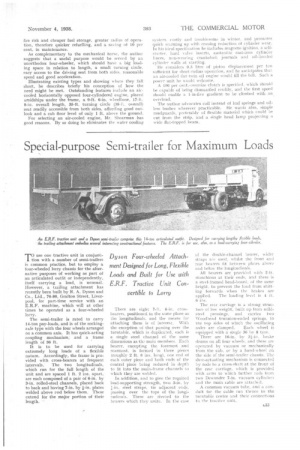Special-purpose Semi-trailer for Maximum Loads
Page 51

If you've noticed an error in this article please click here to report it so we can fix it.
Dyson Four-wheeled Attachment Designed for Long, Flexible Loads and Built for Use with E.R.F. Tractive Unit Con vertible to Lorry
Tuse one tractive unit in conjunt-t:lion with a number of semi-trailers is common practice, but to employ a four-wheeled lorry chassis for the alternative• purposes of working as part of an articulated outfit or independently, itself carrying a load, is unusual. However, a trailing attachment has recently been built by R. A. Dyson and Co., Ltd., 76-80, Grafton Street, Liverpool, for part-time service with an E.R.F. machine, which will at other times be operated as a four-wheeled lorry.
The semi-trailer is rated to carry 14-ton pay-loads, and is of the rockingaxle type with the four wheels arranged on a common axis. It has quick-acting coupling mechanism, and a frame length of 36 ft.
It is to be used for carrying extremely long loads of a flexible nature. Accordingly, the frame is provided with cross-bearers at frequent intervals. The two longitudinals, which run for the full length of the unit and are spaced 1 ft. 2 ins, apart, are each composed of a pair of 6-in, by 3-in, rolled-steel channels, placed back to back and having 7-in. by 1-in. plates welded above end below them. These extend for the major portion of their length.
There are eight 7-ft. 6-in. crossbearers, positioned in the same plane as the longitudinals, and the means for attaching them is of interest. With the exception of that passing over the turntable, which is duplicated, each is a single steel channel of the same dimensions as the main members. Each bearer, excepting the foremost and rearmost, is formed in three pieces (roughly 2 ft. 6 ins. long), one end of each outer piece and both ends of the central piece being reduced in depth to fit into the main-frame channels to which they are welded.
In addition, and to give the required load-supporting strength, two 3-in. by 2,-in. steel straps, tie adjacent ends, passing over the tops of the long:tudinals. These are riveted to the hearers which they unite. In the case
of the double-channel bearer, wider straps are used, whilst the front and rear bearers lit between plates above awl below the longitudinals.
All bearers are provided with 2-ft. stanchions at their ends, and there is a steel-framed head-board, of the same height, to prevent the load from shifting forwards when the brakes are applied. The loading level is 4 ft. 6 ins.
The rear carriage is a strong structure of low weight, built up from mildsteel pressings, and carries two Wood head trunniou-ended springs, to the top sides of which the oscillating axles are clamped. Each wheel is equipped with a single 36 by 8 tyre.
There are 16-in. by 3,1-in. brake drums on all four wheels, and these are operated by vacuum or mechanically from the cab, or by a hand-wheel on the side of the semi-trailer chassis. The shoe-actuating mechanism is connected by rods to a cross-shaft at the front -of the rear carriage, which is provided with arms to which further rods from two Dewandre 7-in. vacuum cylinders and the main cable are attached.
A common vacuum tube, and a conduit for the cable run thence to the turntable centre and their connections ta the tractive unit,




















































































